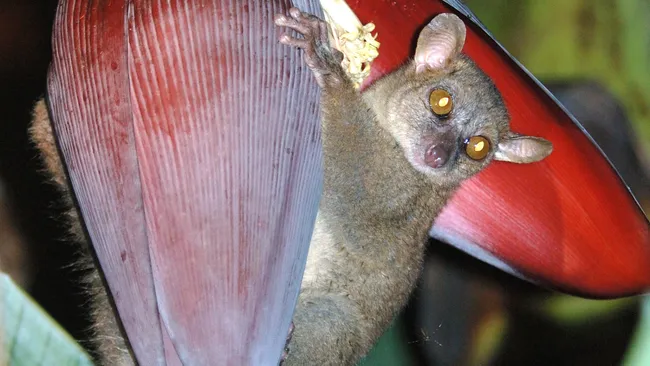If humans had a similar body ratio to the northern giant mouse lemur, their testicles would be the size of grapefruits.
Northern Giant Mouse Lemur (Mirza zaza)
Where it lives:
Northern Madagascar — specifically the forests of the Ampasindava Peninsula in the northwest.
What it eats:
Fruits, flowers, nectar, tree sap, and small insects — a varied diet rich in nutrients.
Why it’s awesome:
This tiny primate packs a lot of surprises in its small frame. At just 10 inches long (excluding tail) and weighing about 10 ounces (300 grams), the Northern giant mouse lemur is one of nature’s most fascinating overachievers.
But what truly sets them apart? Their enormous testicles.
No joke — their testicles make up around 5% of their body weight, which gives them the largest testes-to-body ratio of any primate on the planet. For a human, that would be like lugging around grapefruit-sized gonads, according to New Scientist. And yes, these lemurs sometimes bruise themselves while leaping between branches. Nature can be brutal and awkward.
The evolutionary reason behind this is tied to their polygynandrous mating system, where both males and females have multiple partners. In this high-stakes game of reproductive roulette, more sperm = better odds of fathering offspring. Since these lemurs can reproduce year-round (thanks to a constant supply of nutrient-rich food), their testicles stay large all year long — no off-season in this reproductive race.
More cool traits:
- Big reflective eyes to navigate the night.
- Long fluffy tails for balance in the treetops.
- Thin, sensitive ears that catch the faintest predator rustle.
Females handle parenting solo, typically giving birth to one baby after a 3-month pregnancy, and can have two to three infants per year. Young lemurs reach maturity in about a year.
They also build communal sleeping nests — cozy treetop homes that can house up to eight lemurs, including different ages and both sexes. Scientists think this rare social setup might help them stay warm and conserve energy during chilly nights.
Despite being only discovered in 2005, Mirza zaza has quickly earned its spot as one of Madagascar’s most unique and scientifically intriguing creatures.
Small size, big personality — and even bigger… well, you get the idea.
